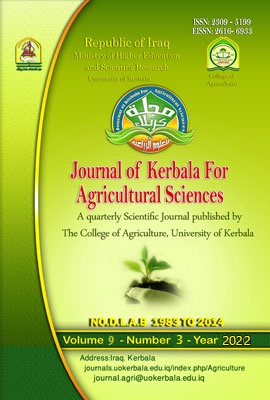Chromatographic separation and identification of fatty acids and phenolic compounds from the seeds of Citrullus colocynthis L. schrad plant growing in Iraq
DOI:
https://doi.org/10.59658/jkas.v9i3.996Keywords:
Citrullus colocynthis (L.) Schrad, fatty acids, acid hydrolysis, phenolic compounds, saponificationAbstract
The current research was presented the phytochemical composition of Citrullus colocynthis schrad seed extracts and it was aimed of the separation and identification of fatty acids from this plant by using a continuous soxhlet apparatus and sequence solvent systems depending on the polarity , the extracts hexane (CI1) ,chIoroform (CI2), ethyl acetate (CI3), ethanol (CI4) and hot aqueous (CI5) were obtained from this seeds and saponification process was done to obtain the free fatty acid compounds ( palmatic, stearic, oleic, linoleic and elaidic acids ). The increasing of concentrations of fatty acid compounds was appeared from CI5 to CI1 because of decreasing of the polarity. Also, the extracts (CI3, CI4 and CI5) were carried out by the acid hydrolysis process to get the free phenolic compounds, which were identified by HPLC technique. The phenolic compounds, which were appeared in C. colocynthis Schrad seed extracts (Rutin , Caffeic acid , Ellagic acid , Gallic acid , Quercetin , Myricetin , Luteolin). Rutin and ellagic acid were appeared in the extracts ( CI3,CI4 and CI5) .Also Caffeic acid and Gallic acid was identified in CI3 and CI4 , while Quercetin and Myricetin were showed in CI4 and CI5. Finally Luteolin was only appeared in CI5.
Downloads
Published
How to Cite
Issue
Section
License
Copyright (c) 2022 Copyright (c) 2024 is the Author's article. Published by the Journal of Kerbala for Agricultural Sciences under a CC BY 4.0 license

This work is licensed under a Creative Commons Attribution 4.0 International License.
Licensing Terms
All articles are published under a Creative Commons License and will be directed to the Creative Commons Attribution 4.0 International License (CC BY 4.0) That permits use, distribution, and reproduction in any medium, provided the original work is properly cited. This license also allows the work to be used for commercial purposes.
Use by both non-commercial and commercial users
This content is licensed under a Creative Commons Attribution 4.0 International (CC BY 4.0) license, permitting use by both non-commercial and commercial users. Individual users may access, download, copy, display, and redistribute the articles to colleagues, as well as adapt, translate, and text- and data-mine the content, subject to the following conditions:
- The author's moral rights, including the right of attribution and the right to protect their work from derogatory treatment, are respected.
- Where content in the article is identified as belonging to a third party, users must ensure that any reuse complies with the copyright policies of the owner of that content.
- If the article content is reused for research or educational purposes, users should maintain a link to the appropriate bibliographic citation, including the DOI and a link to the published version on the journal's website.






